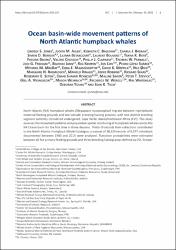| License | Creative Commons Attribution-NonCommercial 4.0 International License. | es |
| Author | Jones, Lindsey | |
| Author | Allen, Judith | |
| Author | Basran, Charla | |
| Author | Berrow, Simon | |
| Author | Betancourt Fernández, Liliana M. | |
| Author | Bouveret, Laurent | |
| Author | Boye, Tenna | |
| Author | Broms, Fredrik | |
| Author | Chosson, Valerie | |
| Author | Clapham, Phillip | |
| Author | Fernald, Thomas | |
| Author | Frediani, Jodi | |
| Author | Jann, Beatrice | |
| Author | Kempen, Reg | |
| Author | López Suárez, Pedro | |
| Author | Magnúsdóttir, Edda | |
| Author | Mattila, David | |
| Author | MacKay, Mithriel | |
| Author | Øien, Nils | |
| Author | Rasmussen, Marianne | |
| Author | Rinaldi, Manolo | |
| Author | Robbins, Jooke | |
| Author | Sears, Richard | |
| Author | Seton, Rosemary | |
| Author | Simon, Malene | |
| Author | Reynoso, Omar Shamir | |
| Author | Stevick, Peter | |
| Author | Todd, Sean | |
| Author | Weinrich, Mason | |
| Author | Wenzel, Frederick | |
| Author | Whitehead, Hal | |
| Author | Young, Deborah | |
| Author | Balcomb, Kenneth | |
| Author | Lien, Jon | |
| Author | Víkingsson, Gislí | |
| Accessioned date | 2025-07-26T18:38:46Z | |
| Available date | 2025-07-26T18:38:46Z | |
| Year | 2025 | |
| Citation | Jones, L., Allen, J., Basran, C., Berrow, S., Betancourt, L., Bouveret, L., ... & Víkingsson, G. (2025). Ocean basin-wide movement patterns of North Atlantic humpback whales. Journal of Cetacean Research and Management, (26), 1-19. Recuperado de: | es |
| URI | https://bvearmb.do/handle/123456789/6553 | |
| Abstract | North Atlantic (NA) humpback whales (Megaptera novaeangliae) migrate between high‐latitude maternal feeding grounds and low‐latitude breeding/calving grounds, with one distinct breeding segment currently considered endangered: Cape Verde Islands/northwest Africa (CVI). This study assesses the movement patterns and population spatial structuring of humpback whales across the NA Ocean basin for the first time in three decades. Photo‐ID records from collections contributed to the North Atlantic Humpback Whale Catalogue, a dataset of 38,319 records of 9,977 individuals documented between 1980 and 2015 were analysed. Transition probabilities were estimated between all five primary feeding grounds and three breeding/calving areas defined as CVI, Greater Antilles and Lesser Antilles, dividing the West Indies distinct population segment into two, based on emerging trends. Breeding‐to‐feeding area transition probabilities were highest from the Greater Antilles to western feeding grounds (the Gulf of Maine, Atlantic Canada and West Greenland), from the Lesser Antilles to eastern feeding grounds (Norway and Iceland), and from CVI to eastern feeding grounds. The difference in migratory patterns of humpback whales using the Greater Antilles and Lesser Antilles regions within the West Indies indicates that they are behaviourally distinct and may be best managed as separate breeding populations. | es |
| Language | English | es |
| Published | Journal of Cetacean Research and Management, (26), 1-19 | es |
| Rights | Available at: https://journal.iwc.int/index.php/jcrm/article/view/951 | es |
| Rights URI | https://creativecommons.org/licenses/by-nc/4.0/ | es |
| Subject | Biodiversidad - República Dominicana | es |
| Subject | Fauna ─ República Dominicana | es |
| Subject | Hábitats y especies | es |
| Subject | Mamíferos marinos | es |
| Title | Ocean basin-wide movement patterns of North Atlantic humpback whales | es |
| dc.identifier.doi | https://doi.org/10.47536/jcrm.v26i1.951 | |
| URL | https://journal.iwc.int/index.php/jcrm/article/view/951 | |
| Material type | Article | es |
| Type of content | Scientific research | es |
| Access | Open | es |
| Audience | Technicians, professionals and scientists | es |


